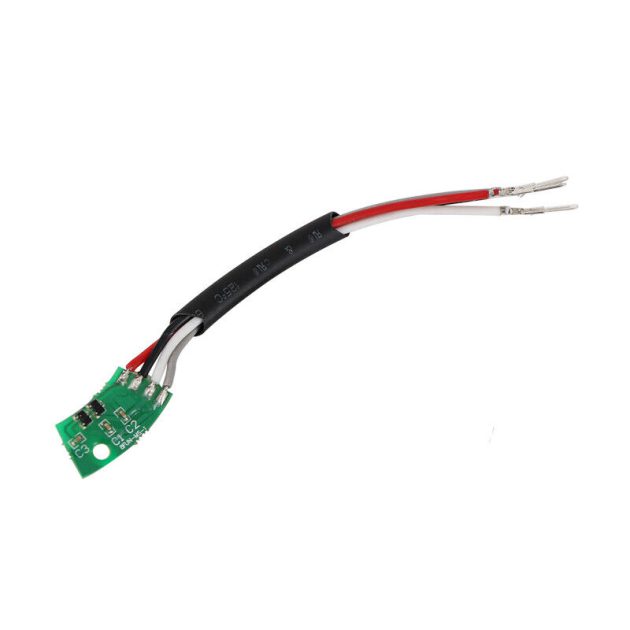A hall sensor is a type of magnetic sensor that helps detect the direction and strength of a magnetic field.
Commonly found in ebike motors, the hall sensor can detect the position of a rotor in a motor.
So what is it used for?
Thanks to the use of a hall sensor, it helps determine whether an ebike is on or off. Besides determining if an ebike is on or off, the hall sensor can also help regulate the power output, motor speed, wheel speed, and detect if the ebike is in motion or stationary.
As a transducer, a hall sensor varies its output voltage in response to the magnetic field. The sensor has three wires: red for +5V, black for ground, and the third wire for the output signal. The latter switches between ground and 4V, especially when it senses a magnetic field.
Once the sensor detects a magnetic field, it sends a signal to the controller and provides the motor’s position. In turn, the signal adjusts the power supplied by the motor.

Types of Hall Sensors
There are two types of hall sensors.
- Linear or Analog Sensors
Analogue hall sensors use a continuous voltage output that decreases in a weaker magnetic field and increases in a stronger field. As the strength of the magnetic field increases when the devices come into contact with a magnet, the output signal increases. In fact, it does so until it reaches the power supply limits.
- Digital Hall Sensors
There are two types of digital hall sensors – bipolar and unipolar. Bipolar hall sensors need a positive magnetic field to operate. They also use the negative field from the North Pole to release.
When it comes to unipolar sensors, they only need a positive magnetic field to operate and release. The devices come with a Schmitt trigger. This is a bistable circuit that increases and decreases the output as the voltage rises and falls. Thanks to the trigger, when the magnetic flux exceeds the device’s default value, the device switches from ‘off’ to ‘on.’
How Does a Hall Sensor Work?
A motor can have up to three hall sensors fitted on the rotor. These sensors are commonly placed 120 degrees apart from each other. When these sensors detect the rotor’s magnetic field, they generate a digital pulse or signal.
If the signal from the hall sensor is high, it means one of the magnets in the motor is passing by. When the signal is low, that means the motor’s magnet already passed.
On an ebike, the hall sensor monitors the position and speed of the motor. If it detects a magnetic field, it sends a signal to the e-bike’s controller. The controller uses the signal to adjust the motor’s power supply. Basically, it can increase or decrease the power supply of the motor.
When it increases the power supply, your ebike goes faster and when it decreases the power, your ebike goes slower.
What Happens if a Hall Sensor Fails?
A hall sensor can fail or break due to overheating, over-voltage, shortcircuiting, water damage, or some other reason. If this happens to your ebike’s motor, it means the motor won’t work. This is because the hall sensor gives feedback to the motor control system.
Basically, it indicates when the rotor reached the desired position. If the signal sent is faster or slower than the rotor’s speed, the magnets go out of sync with the stator’s magnetic field. This causes the rotor to stop and vibrate instead of rotating. If your ebike hall sensor fails, it may flash error code 03 on the display.
There are several symptoms of a faulty or dead hall sensor. They include:
- Loss of power
- Stalling
- Trouble starting the ebike
- Loud noises from the motor
- Whining sound
To know if a hall sensor is faulty, you need a multimeter and a source of electricity.
How Do You Test Hall Sensors?
As before mentioned, you need a multimeter and a source of electricity to test a hall sensor. We recommend a small battery with 5 volts. Disconnect all the cables before you start the test. Cables that must remain connected during the test include:
- All motor cables connected to the control
- Hall sensor cables
- Throttle cable.
Here are the testing steps.
Step 1 – Connect the hall sensor’s cable to the power source. You can use an external 5-volt battery or the ebike’s battery.
Step 2 – Power on your multimeter
Step 3 – Take the negative probe of the multimeter and insert it in the hall sensor black wire slot
Step 4 – Take the positive probe and place it into the red wire slot
Step 5 – Now, rotate the motor using your hand and watch the multimeter reading. If the reading jumps from zero to five as you rotate the motor, then the hall sensor is fine. However, if the reading on the multimeter is fixed on zero or five, then the hall sensor is faulty or dead.
Why Do We Need Hall Sensors?
A hall sensor plays the crucial role of detecting the strength and position of a magnetic field. It also detects the position and speed of the motor. This information is necessary for the motor to adjust the power supply. By adjusting the power supply accordingly, your ebike can travel faster or slower. This ensures better and smooth performance.
Hall sensors are commonly used on ebikes because they help to make them more efficient. They also help reduce the wear and tear of the motor. Hall sensors are commonly used because they operate without any mechanical parts. This makes them very reliable. Also, the hall sensors do not need lots of repairs or maintenance as they are usually not affected by friction.
Conclusion
Hall sensors are critical components used in ebikes to measure the position and speed of the motor. They do so by sensing the strength and direction of the magnetic field. The device outputs a signal proportional to the motor’s speed.
The controller then regulates the power to the motor. Without hall sensors, it would be difficult to operate ebikes within safe operating limits. Also, the motor could overheat and get damaged.
Now that you know what a hall sensor is and the importance it holds, in case of power loss, or loud noises, you can identify the issue as a faulty hall sensor.
